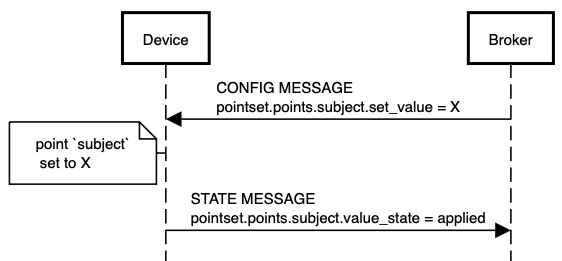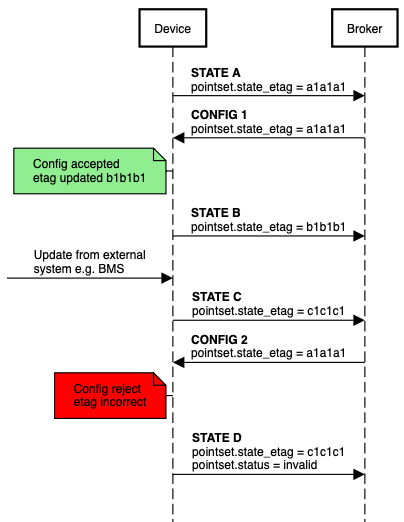udmi
UDMI / Docs / Specs / Sequences / Writeback
Writeback
This file documents UDMI’s specification for cloud to device control i.e. writeback. At a high level, the cloud controls a device by writing to the pointset block in the device config. After receiving the config, the device updates its state to reflect the status of the writeback attempt e.g. success, failure, etc.

Generated using <https://sequencediagram.org>
participant Device
participant Broker
entryspacing 0.1
Broker->Device: CONFIG MESSAGE\npointset.points.subject.set_value = X
note left of Device: point `subject`\n set to X
Device->Broker: STATE MESSAGE\npointset.points.subject.value_state = applied
space -2
Cloud Behavior
To write to a point, the cloud sets three fields in the device config:
set_value, which specifies the value for a given point in the device’s current units.state_etagvalue which uniquely represents the state. Specifically,state_etagis used to avoid race conditions where the incoming config is based off an obsolete state.set_value_expiry, which contains the RFC 3339 timestamp at which allset_valuevalues expire.
Device Behavior
After receiving the config message, the device attempts to write the value to the point. Depending
on the status of the write, the device should populate the value_state
value_state
The value_state field is an enumeration within a state message representing
the status of a point’s writeback attempt.
Possible states for value_state:
- <missing> – The
value_statefield is missing from this point. This means one of two things:- The device is sending telemetry specified by the device as per normal operation. This is the more likely case.
- The point’s config does not follow the UDMI spec for writeback. E.g. instead of specifying
set_value, the config misspelled as , which isn’t a valid field in UDMI, and is ignored by the device.
- applied – The cloud value is applied to the device point. The point should now be reporting as telemetry the value defined in the device’s config.
- updating – The system is working to make the device state match the requested config. If the system hasn’t reconciled the config within 5 seconds or before the next telemetry message (whichever comes first), then the system should send a state message with
value_stateset to updating. While the system should never abort trying to reconcile the config, after 1 minute of attempting to reconcile, the system should setvalue_stateto failure. - overridden – The device point has been superseded by another system/user with a higher priority.
- invalid – The system failed to write the value to the point because the requested value cannot be applied to the point. This state indicates an error on the cloud side. Some examples:
- Point is not writable
- Requested value is out of the operating bounds of the point
- The
state_etagon the device doesn’t match thestate_etagfrom the incoming config
- failure – The system failed to apply the cloud value to the point because an error occurred on the device side.
In the case of any of the error states (failure, invalid, overridden), the status field for the point should be populated to provide additional debugging information about the error.
state_etag
The state_etag field is meant to prevent a race condition where the device could apply a config
change based off an obsolete device state. The state_etag is a hash value of point units, config
set values echo and value_states in the points block. The state_etag must be updated to reflect
any updates in the pointset block. The specific calculation of state_etag is left up to
implementation, but the value should be a unique hash of the state’s pointset. The state_etag
should be included by state and config. When the device receives a new config with a valid
state_etag, regardless of update success or failure.

Example
An example of how the state_etag works and the race condition this field prevents:
1) The device is in state A. For example, it specifies units Fahrenheit for some writable point P.
2) The cloud sends a config update to write the value 70 to point P.
3) The device state changes state B, where point P is now using units Celsius. This change can happen manually through the BMS, or through other mechanisms.
4) The device receives the cloud’s config update, and sets the value of point P to 70 Celsius, instead of the intended 70 Fahrenheit.
state_etag prevents this race condition by ensuring that the device state doesn’t change between when the config was sent and received. i.e. in the previous example, the cloud’s config update would include a state_etag uniquely representing state A. Upon receiving the update, the device would detect that the current state_etag (uniquely representing state B) is not the same as the one in the config, and therefore set the value_state as invalid.
Value Expiration
When the device receives a config, it should check that set_value_expiry exists and is greater than the timestamp field in the config, sending an invalid value_state if not.
If the set_value_expiry has already passed, then there’s no write to perform, so the state of the device shouldn’t change (i.e. this is a no-op)
If the config passes these checks, then the device should
1) perform the write
2) set a timer to trigger at the given set_value_expiry, overwriting any existing timer.
When the timer expires, the device reverts to its base state (as if no set values have been indicated), and sends a state update to notify the cloud of the state change.